Related Research Articles

Cajun cuisine is a style of cooking developed by the Cajun–Acadians who were deported from Acadia to Louisiana during the 18th century and who incorporated West African, French and Spanish cooking techniques into their original cuisine.

New Orleans is a consolidated city-parish located along the Mississippi River in the southeastern region of the U.S. state of Louisiana. With a population of 383,997 according to the 2020 U.S. census, it is the most populous city in Louisiana, third most populous city in the Deep South, and the twelfth-most populous city in the southeastern United States. Serving as a major port, New Orleans is considered an economic and commercial hub for the broader Gulf Coast region of the United States. New Orleans is also a region of French Louisiana, along with the Cajun Country.

The French Quarter, also known as the Vieux Carré, is the oldest neighborhood in the city of New Orleans. After New Orleans was founded in 1718 by Jean-Baptiste Le Moyne de Bienville, the city developed around the Vieux Carré, a central square. The district is more commonly called the French Quarter today, or simply "The Quarter", related to changes in the city with American immigration after the 1803 Louisiana Purchase. Most of the extant historic buildings were constructed either in the late 18th century, during the city's period of Spanish rule, or were built during the first half of the 19th century, after U.S. purchase and statehood.

Louisiana Creole cuisine is a style of cooking originating in Louisiana, United States, which blends West African, French, Spanish, and Native American influences, as well as influences from the general cuisine of the Southern United States.

Gumbo is a stew popular in the U.S. state of Louisiana, and is the official state cuisine. Gumbo consists primarily of a strongly flavored stock, meat or shellfish, a thickener, and the Creole "holy trinity" – celery, bell peppers, and onions. Gumbo is often categorized by the type of thickener used, whether okra or filé powder.

Jambalaya is an American Creole and Cajun rice dish of French, African, and Spanish influence, consisting mainly of meat and vegetables mixed with rice.

A po' boy is a sandwich originally from Louisiana. It traditionally consists of meat, which is usually roast beef, chicken fingers, or fried seafood such as shrimp, crawfish, fish, oysters, or crab. The meat is served on New Orleans French bread, known for its crisp crust and fluffy center.
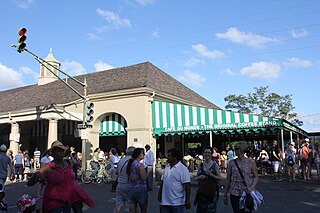
Café du Monde is a renowned open-air coffee shop located on Decatur Street in the French Quarter of New Orleans, Louisiana, United States. It is a New Orleans landmark and tourist destination, known for its café au lait and beignets. Its coffee with chicory is widely available in the continental United States.

The history of New Orleans, Louisiana traces the city's development from its founding by the French in 1718 through its period of Spanish control, then briefly back to French rule before being acquired by the United States in the Louisiana Purchase in 1803. During the War of 1812, the last major battle was the Battle of New Orleans in 1815. Throughout the 19th century, New Orleans was the largest port in the Southern United States, exporting most of the nation's cotton output and other farm products to Western Europe and New England. As the largest city in the South at the start of the Civil War (1861–1865), it was an early target for capture by Union forces. With its rich and unique cultural and architectural heritage, New Orleans remains a major destination for live music, tourism, conventions, and sporting events and annual Mardi Gras celebrations. After the significant destruction and loss of life resulting from Hurricane Katrina in 2005, the city would bounce back and rebuild in the ensuing years.
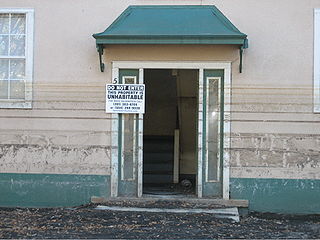
The reconstruction of New Orleans refers to the rebuilding process endured by the city of New Orleans after Hurricane Katrina destroyed much of the city on August 29, 2005. The storm caused levees to fail, releasing tens of billions of gallons of water. The levee failure contributed to extensive flooding in the New Orleans area and surrounding parishes. About 80% of all structures in Orleans Parish sustained water damage. Over 204,000 homes were damaged or destroyed, and more than 800,000 citizens displaced—the greatest displacement in the United States since the Dust Bowl of the 1930s. Wind damage was less severe than predicted. The damage that took place that needed to be repaired cost about $125 billion.
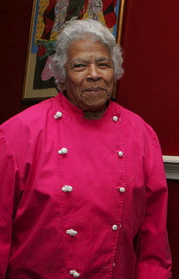
Leyah (Leah) Chase was an American chef based in New Orleans, Louisiana. An author and television personality, she was known as the Queen of Creole Cuisine, advocating both African-American art and Creole cooking. Her restaurant, Dooky Chase, was known as a gathering place during the 1960s among many who participated in the Civil Rights Movement, and was known as a gallery due to its extensive African-American art collection. In 2018 it was named one of the 40 most important restaurants of the past 40 years by Food & Wine.
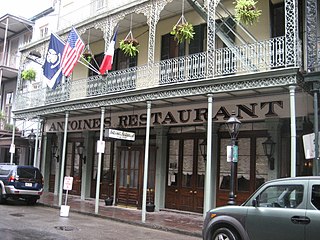
Antoine's is a Louisiana Creole cuisine restaurant located at 713 rue St. Louis in the French Quarter of New Orleans, Louisiana. It is one of the oldest family-run restaurants in the United States, having been established in 1840 by Antoine Alciatore. A New Orleans institution, it is notable for being the birthplace of several famous dishes, such as Oysters Rockefeller, pompano en papillote, Eggs Sardou and Pigeonneaux Paradis. Antoine's Cookbook, compiled by Roy F. Guste features hundreds of recipes from the Antoine's tradition. It is also known for its VIP patrons including several U.S. presidents and Pope John Paul II.

The culture of New Orleans is unique among, and distinct from, that of other cities in the United States, including other Southern cities. New Orleans has been called the "northernmost Caribbean city" and "perhaps the most hedonistic city in the United States". Over the years, New Orleans has had a dominant influence on American and global culture.

Austin Leslie was an internationally famous New Orleans, Louisiana, chef whose work defined 'Creole Soul'. He died in Atlanta, Georgia, at the age of 71 after having been evacuated from New Orleans; he had been trapped in his attic for two days in the 98 °F heat, in the aftermath of the August 29 Hurricane Katrina. He was honored with the first jazz funeral after Katrina on October 9, 2005, in the still largely-deserted city. The procession, led by the Hot 8 Brass Band, marched through the flood-ravaged remains of Leslie's old Seventh Ward neighborhood, starting out at Pampy's Creole Kitchen and stopping along the way at the location of the original Chez Helene.

St. Roch is a neighborhood of the U.S. city of New Orleans. A subdistrict of the Bywater District Area, its boundaries as defined by the City Planning Commission are: Lafreniere Street, Paris Avenue, I-610, Benefit Street, and Dahlia Walk to the north; People's and Almonaster Avenues to the east; St. Claude Avenue to the south; Elysian Fields Avenue, Hope, Frenchmen, Duels, St. Anthony, Industry, Allen, & Agriculture Streets, A.P. Tureaud Avenue, Abundance, Republic, Treasure, & Dugue Streets, and Florida & St. Bernard Avenues to the west.
The culture of Louisiana involves its music, food, religion, clothing, language, architecture, art, literature, games, and sports. Often, these elements are the basis for one of the many festivals in the state. Louisiana, while sharing many similarities to its neighbors along the Gulf Coast, is unique in the influence of Louisiana French culture, due to the historical waves of immigration of French-speaking settlers to Louisiana. Likewise, African-American culture plays a prominent role. While New Orleans, as the largest city, has had an outsize influence on Louisiana throughout its history, other regions both rural and urban have contributed their shared histories and identities to the culture of the state.
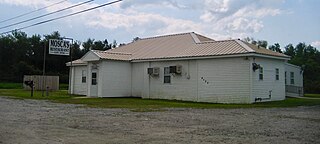
Mosca's is a Louisiana Creole Italian restaurant in Waggaman, Louisiana, near New Orleans. Operated by the same family since it opened in 1946, it has long been regarded as one of New Orleans' best restaurants, known for dishes such as Oysters Mosca, crab salad, Chicken a la Grande, and pineapple fluff.

The cuisine of New Orleans encompasses common dishes and foods in New Orleans, Louisiana. It is perhaps the most distinctively recognized regional cuisine in the United States. Some of the dishes originated in New Orleans, while others are common and popular in the city and surrounding areas, such as the Mississippi River Delta and southern Louisiana. The cuisine of New Orleans is heavily influenced by Creole cuisine, Cajun cuisine, and soul food. Later on, due to immigration, Italian cuisine and Sicilian cuisine also has some influence on the cuisine of New Orleans. Seafood also plays a prominent part in the cuisine. Dishes invented in New Orleans include po' boy and muffuletta sandwiches, oysters Rockefeller and oysters Bienville, pompano en papillote, and bananas Foster, among others.

The Parish was a Cajun, Louisiana Creole, and seafood restaurant in Portland, Oregon's Pearl District, in the United States. It was opened by Tobias Hogan and Ethan Powell in 2012, and became known for its oysters. In 2015, the restaurant was split in half, and one side of the space began serving brunch, lunch, and happy hour as the Palmetto Cafe. The Palmetto was converted into a private event space and pop-up restaurant in February 2016, and The Parish closed abruptly in September of that year.

Eat: An Oyster Bar is a Cajun and Louisiana Creole restaurant in Portland, Oregon.
References
- ↑ "Crescent City Farmers Market Turns Two" (Press release). Loyola University New Orleans. 1997-09-19. Archived from the original on 2014-03-23. Retrieved 2008-07-16.
- ↑ "Archived copy". Archived from the original on 2007-08-10. Retrieved 2006-10-30.
{{cite web}}: CS1 maint: archived copy as title (link) - Crescent City Farmers Market website